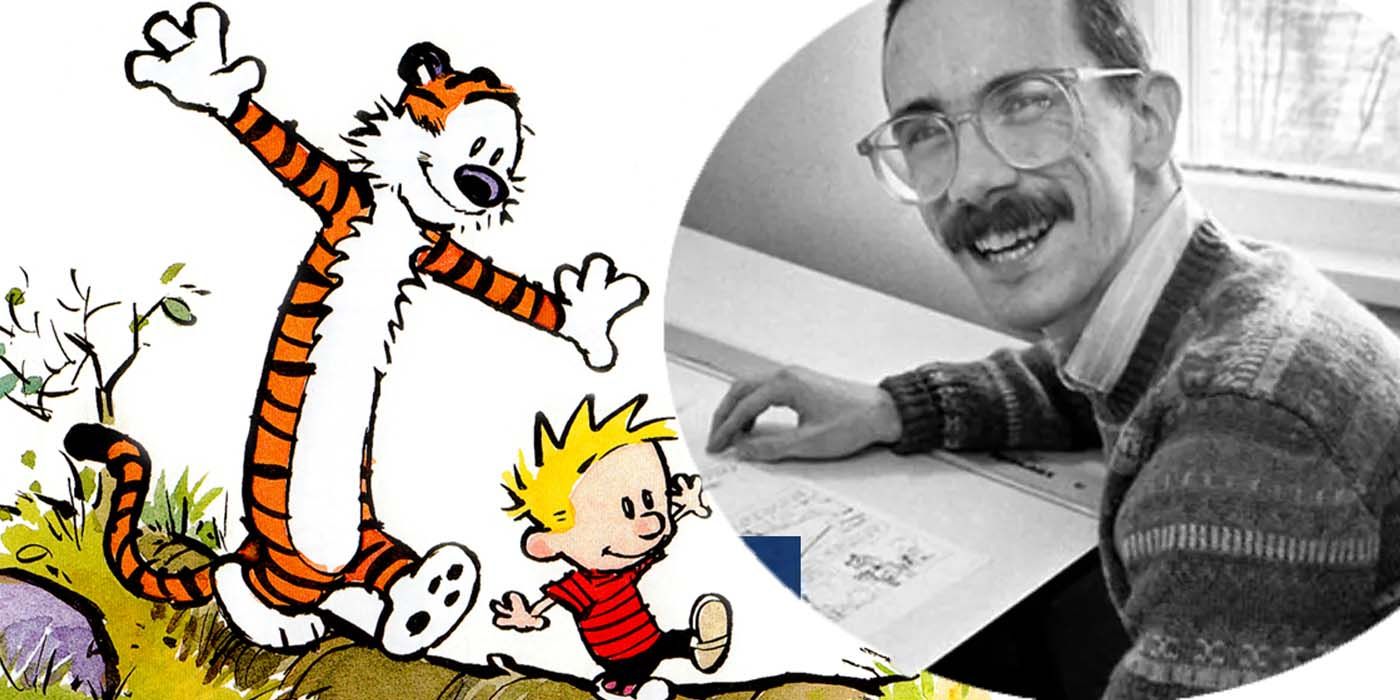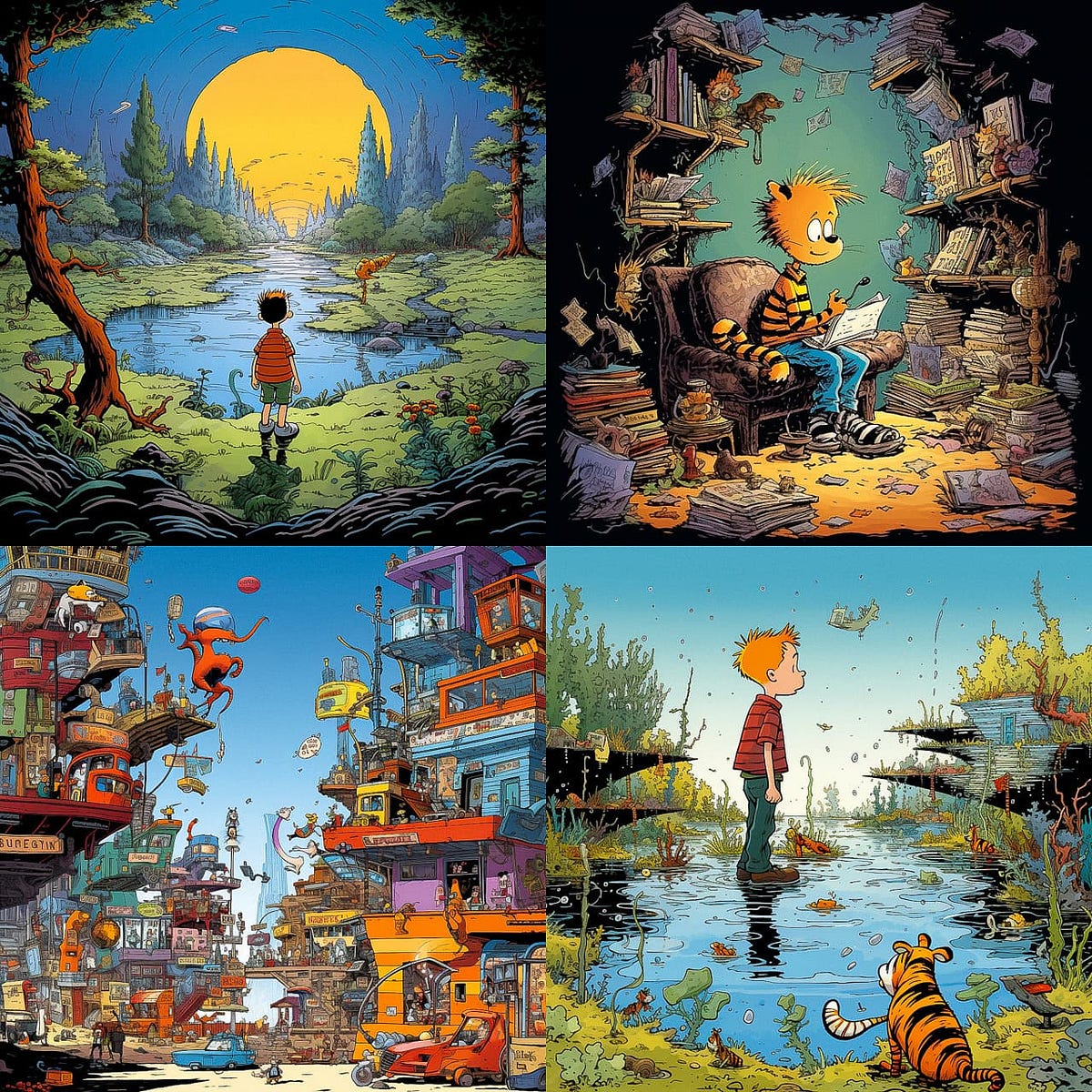For so many folks who grew up with a mischievous boy and his stuffed tiger, the name Bill Watterson brings back a whole lot of really good feelings. This American cartoonist, William Boyd Watterson II, is the person who gave the world the truly beloved comic strip called Calvin and Hobbes. It's almost as if, after a long quiet period, he has given us a new reason to celebrate, with his first book, ‘The Mysteries,’ making its appearance on October 10.
You see, this strip, Calvin and Hobbes, was out there for everyone to enjoy from 1985 until 1995, and it really captured the hearts of many. It told stories of a boy and his tiger, full of imagination and witty conversations, which, you know, just connected with people across generations. For a long while after that, Mr. Watterson pretty much kept to himself, focusing on other artistic pursuits.
So, his return to publishing, after nearly three decades, is actually quite a big deal for those who admired his earlier work. This new book, a fable, carries some of that familiar feeling from his famous comic strip, offering a sense of wonder and, perhaps, a bit of the unexpected. We’re going to take a closer look at the life and work of this rather unique creator.
Table of Contents
- The Story of Bill Watterson
- What is the Enduring Appeal of Bill Watterson's Calvin and Hobbes?
- The Strip's Run - Bill Watterson's Creative Span
- Why Did Bill Watterson Step Away?
- Bill Watterson's Artistic Path After the Strip
- What is "The Mysteries" by Bill Watterson All About?
- The Return to Print - Bill Watterson's Fable
- How Has Bill Watterson Influenced Generations?
The Story of Bill Watterson
William Boyd Watterson II came into the world on July 5, 1958. He was born in Washington, D.C., which is, you know, a pretty interesting place to start out. From those beginnings, he would eventually grow into a person who would create something truly special, something that would stick with people for a very long time. His journey as a cartoonist, as a matter of fact, would see him craft one of the most recognizable and, quite frankly, cherished comic strips that has ever existed.
People usually know him as Bill Watterson, and he is a cartoonist from America. His main claim to fame, the thing he is best known for, is being the author of the comic strip Calvin and Hobbes. That strip, which, you know, many of us grew up with, became a classic. It’s a story about a boy and his tiger, and it really captured the wild, free spirit of childhood. This creative person, Bill Watterson, has, in some respects, shaped how many of us see imagination.
His life, like anyone’s, has had its own unique path. We know he’s a cartoonist who has done some really significant work. A lot of folks consider him a renowned artist, particularly for his creation of Calvin and Hobbes. There’s a whole story there, you know, covering his younger years, his general life experiences, and how he got into the business of drawing comics. It includes the things he has managed to achieve and, of course, the timeline of his career.
It is that, the timeline of his creative life, that many find fascinating. For example, July 5, 2018, was a pretty special day, as it marked the 60th birthday of this person, this legendary comic creator, Bill Watterson. That date, in a way, really brought home how much time had passed since his strip first appeared, and how much it had become a part of so many people's lives.
Here is a brief overview of some personal details about Bill Watterson:
| Detail | Information |
|---|---|
| Full Name | William Boyd Watterson II |
| Born | July 5, 1958 |
| Birthplace | Washington, D.C., USA |
| Known For | Authoring the comic strip Calvin and Hobbes |
| Other Work | Mostly leaned into art after Calvin and Hobbes; authored "The Mysteries" |
What is the Enduring Appeal of Bill Watterson's Calvin and Hobbes?
So, what is it about this particular comic strip, the one created by Bill Watterson, that makes people keep coming back to it? It’s a classic, really, a story about a boy named Calvin and his tiger, Hobbes. Their adventures take place in Calvin’s very own imaginative world, which, you know, is just bursting with creativity. This world is where a stuffed tiger can suddenly become a living, breathing best friend, full of opinions and playful mischief.
The strip, in fact, has entertained generations of readers. It’s done this by bringing a very witty kind of humor and a deep sense of childhood wonder to the page. The conversations between Calvin and Hobbes are, quite frankly, often quite clever, sometimes even a bit philosophical, but always, always, they feel real. They talk about everything from school and homework to the meaning of life and the nature of friendship.
It’s not just the funny parts, either. There’s a certain magic to how Bill Watterson captured the spirit of being a child, the way kids see the world, full of possibilities and sometimes, you know, a little bit of chaos. The bond between Calvin and Hobbes is something that many people can relate to, that idea of an imaginary friend who is more real than anyone else. This connection, in a way, feels very genuine, which helps the strip stay fresh for new readers.
The art itself, too, is a big part of it. The way Bill Watterson drew Calvin’s expressions, or Hobbes’s tiger-like movements, just added so much to the stories. You could practically feel the energy coming off the page. The strip’s ability to combine humor with heartfelt moments, and to explore big ideas through the eyes of a little boy, is, you know, pretty remarkable. It’s a comic that truly makes you think and feel, which is why it has such a lasting impact.
The Strip's Run - Bill Watterson's Creative Span
The comic strip Calvin and Hobbes had its syndicated run from 1985 to 1995. That’s a ten-year period where, you know, millions of people got to follow the daily antics of Calvin and his tiger. For a comic strip, that’s a pretty good stretch of time, allowing the characters and their world to really grow and develop in the minds of the readers. It became a staple in newspapers across the globe, reaching a truly wide audience.
During this time, Bill Watterson was the sole author and illustrator of the strip. This meant that every single panel, every word of dialogue, and every drawing came directly from his hand and his mind. This kind of creative control is, in some respects, quite rare in the world of syndicated comics, where often many hands are involved. It allowed him to keep the vision for Calvin and Hobbes very pure, very much his own.
The consistent quality of the strip throughout its ten-year run is something that many people still talk about. Each day, readers could expect something new, something funny, or something that would make them think. It was, you know, a daily dose of imagination and wit that became a cherished part of many people’s routines. This dedication to his craft, to maintaining that level of creative output, is actually quite impressive.
The strip’s influence, even after it stopped running, continued to grow. Collections of the strips sold millions of copies, introducing new generations to Calvin and Hobbes. It just goes to show that the stories and the characters Bill Watterson created had a timeless appeal, something that transcended the daily newspaper format. People wanted to keep those adventures close, to revisit them again and again.
Why Did Bill Watterson Step Away?
It’s a question many people have wondered about: why did Bill Watterson decide to stop creating Calvin and Hobbes when it was so popular? The strip was at its peak, really, with a huge following. But in 1995, he chose to bring it to an end. This decision was, you know, quite unusual for a creator with such a successful property, and it left many fans feeling a bit sad, but also very curious.
Part of the reason, it seems, had to do with the pressures of daily syndication. Creating a high-quality comic strip every single day, year after year, is actually a very demanding job. It requires constant ideas, consistent drawing, and a lot of creative energy. Bill Watterson, by all accounts, was very committed to maintaining the artistic integrity of his work, and perhaps the daily grind made that harder to do in the way he wanted.
There’s also the aspect of his personality. Bill Watterson is known to be a rather private person, what some might call reclusive. He preferred to let his work speak for itself and avoided the public spotlight that often comes with such widespread fame. The demands of publicity, of licensing, and of managing a massive franchise were, you know, probably not something he enjoyed. He seemed to value his privacy and his artistic freedom above all else.
He wanted to make sure the strip ended on his own terms, with its quality still high, rather than letting it fade or become something he no longer felt passionate about. He believed that the strip had done what it set out to do, and that continuing it might compromise its original spirit. This choice, to stop while he was ahead, was, in some respects, a very brave one, showing his deep respect for his creation and his own artistic vision.
Bill Watterson's Artistic Path After the Strip
After he decided to end Calvin and Hobbes, Bill Watterson pretty much leaned into art. This means he continued to pursue creative endeavors, but away from the public eye and the demands of a syndicated comic strip. He wasn't just, you know, sitting around doing nothing; he was still creating, still drawing, still exploring different ways to express himself through his artwork. It was a shift, really, from a public-facing role to a more private one.
This period of his life, spanning nearly three decades, was largely quiet in terms of public output. While fans eagerly hoped for a return to comics, Bill Watterson was, apparently, exploring other artistic avenues. What exactly those were, we didn't always know, as he maintained his preference for privacy. But it was clear he was still dedicated to the act of creation, just in a different setting and for different purposes.
It’s interesting to think about what kind of art he might have been making during these years. Perhaps it was painting, or other forms of illustration, or even just sketching for his own enjoyment. The fact that he "leaned into art" suggests a continued passion for visual expression, a need to create that didn't just disappear when Calvin and Hobbes concluded. This sustained engagement with art is, you know, a testament to his true calling.
His artistic journey after the strip was, in a way, a quiet one, but no less meaningful for him. It allowed him to work without the pressures of deadlines, without the expectations of millions of readers, and without the public scrutiny that had come with his earlier fame. This freedom, to simply create for the sake of creating, must have been a very important aspect of his life during those years.
What is "The Mysteries" by Bill Watterson All About?
So, what exactly is this new book, "The Mysteries," that Bill Watterson has released after such a long time? It's called a fable, which means it’s a story meant to teach a lesson or convey a truth, often using characters that are not human. This particular book, you know, came out on October 10, and it marks a very significant moment for his admirers. It’s a chance to experience his storytelling again, but in a fresh form.
The book shares, in some respects, a certain "sense of" wonder or perhaps a particular feeling with his famous comic strip, Calvin and Hobbes. While it's not a comic strip and doesn't feature Calvin or Hobbes, it seems to carry some of that imaginative spirit, that unique way of looking at the world that characterized his earlier work. It’s like getting a glimpse into the same kind of mind that created those beloved characters.
Being a fable, it probably uses symbolic elements and a narrative style that encourages readers to think beyond the surface. It’s not just a straightforward story, but something that invites reflection and interpretation. This approach, you know, aligns pretty well with some of the deeper themes that were sometimes present in Calvin and Hobbes, which often touched on big ideas about life and existence.
The fact that it’s a book, rather than a comic strip, also shows a different side of Bill Watterson's creative expression. It means he’s exploring storytelling in a new medium, using words and perhaps different kinds of illustrations to convey his message. This return to print, with a fable, is, quite frankly, a fascinating development for anyone who appreciates his unique artistic voice.
The Return to Print - Bill Watterson's Fable
Bill Watterson’s return to print, after nearly three decades, is actually quite a moment for those who have followed his work. It comes in the form of this fable called "The Mysteries." This is a big deal because, for so long, he has been known for being a very private person, someone who largely stayed out of the public eye after ending his comic strip. So, a new book, a new story, is a very welcome surprise.
The gap between his last published work, the end of Calvin and Hobbes, and this new book is, you know, almost thirty years. That’s a long time for any artist to be away from the public sphere, especially one whose work was so widely loved. This long period of quietude only adds to the interest and anticipation surrounding "The Mysteries." People are really curious to see what he has created after such a long break.
The choice of a fable as his return vehicle is also quite telling. A fable, as we talked about, often has a deeper meaning, a moral or a philosophical point to make. This suggests that Bill Watterson is still interested in exploring big ideas, in prompting thought and reflection, much like his comic strip often did in its own playful way. It’s not just a casual return, but one with a purpose.
This new book, "The Mysteries," shares a certain feeling with his famous comic strip. While the format and content are different, there’s a thread, a common sensibility, that connects it to his previous work. It’s that, you know, unique blend of wonder, imagination, and a subtle questioning of the world around us. For fans, it's a chance to reconnect with the mind of Bill Watterson in a new and exciting way.
How Has Bill Watterson Influenced Generations?
So, how exactly has Bill Watterson, through his work, particularly Calvin and Hobbes, managed to touch and influence so many different generations of people? His iconic cartoon has, quite simply, entertained readers young and old for a very long time. It’s done this by bringing a kind of witty humor and a deep sense of childhood playfulness that really sticks with you.
For kids, Calvin and Hobbes offered a reflection of their own wild imaginations, their frustrations with adults, and their deep, sometimes silly, friendships. They saw themselves in Calvin’s adventures, in his desire for freedom, and in his unique way of seeing the world. This connection, you know, made the strip feel very personal and very real to young readers, helping them feel understood.
For adults, the


